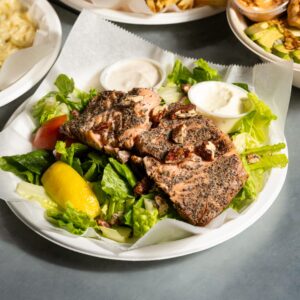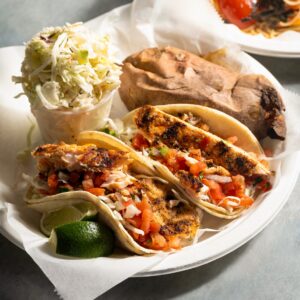Focus on the Finicky

No more food fights! Tips, tricks, and insider secrets on how to feed your picky eater without feuds

I s mealtime in your home a recipe for frustration? A guide for understanding your picky eaters — and getting ’em fed!
Why So Fussy?
Eating habits are generally shaped by a mixture of environment and experience. But sometimes physical neurological and psychological factors play a role as well.
Give Cravings the Cold Shoulder
Bitter Blues
With their smaller physical size children have a naturally lower tolerance for bitter or sour tastes. Kids who are sensitive to these flavors usually display a greater penchant for sugary foods and drinks (though adults who won’t touch a grapefruit don’t typically have the same sweet tooth). If that sounds like your kid take heart: experiments show that bitter or sour flavors may grow on them when combined with sweet foods.
Note: Kids with bitter-sour intolerance were rated “more emotional” by their moms only when the mother displayed bitter-insensitive tendencies. Hmmm....
Caution: Genes at Play
If your son is roundly rejecting dish one two and three try to remember that he’s probably not trying to be difficult. In most cases of picky eaters the “blame” actually goes to the parents with studies showing that genes are a significant influence in kids’ eating tendencies. When the specific genes governing taste are extra-sensitive taste buds are in a perpetual state of high alert and report strong signals to the brain transforming what you would consider simply a disliked food into a horrific experience for a taste-sensitive kid. When it comes to sweet-tooth cravings it’s the same genes at work too.
You Never Know
Could you be a supertaster? The term was coined for people whose tongues possess an extraordinarily high number of taste buds, resulting in the brain receiving powerful taste signals.
Supertasters often avoid strong, flavorful food and drinks such as heavy steaks, rich desserts, or even coffee, because they find them overwhelming. Fats, sugars, and certain vegetables such as turnips and broccoli (which contain bitter molecules) are usually off the menu too. Possibly one in four people may have these genes, which may not be all that bad actually, considering supertasters tend to be thinner and have better cholesterol profiles.
What’s a Mom to Do?
Back to Basics
We all know that kids — and adults — require a combination of the different food groups, including carbs, proteins, and fats, to maintain a well-balanced diet. But fruit and vegetables are still rated as most essential, says Dr. Robert Adler of Segulah Pediatrics in Brooklyn, New York.
“The micronutrients they contain are known to prevent chronic health conditions, such as cancer, diabetes, and heart disease.” To get kids excited about produce, let them pick out their own fruit at the grocery or try threading cut-up fruits onto skewers in fun patterns. “Remember, even if they just take a bite or two, it’s okay,” Dr. Adler says. “It takes time for tastes to develop. Repeated exposure to fruits and veggies — even if miniscule — will nudge their taste buds in the right direction.”
FYI
Picky eating tendencies tend to decline by age six, although it may continue through childhood or beyond.
Easy on the Protein
Although protein is a key nutritional need, some evidence suggests that very high levels of protein can result in negative effects on the liver and kidneys, among other functions. “The role of protein is to promote cellular structure and bone and muscle health, but our main energy source ought to be carbohydrates,” says Zahavah Greenberg, public health educator with a BS in nutrition and health sciences. “Fifty percent of a growing child’s daily intake should be carbs — but good carbs, such as fruits and vegetables, whole-grain bread, rice, or pasta.” Another reason to watch your protein, according to Dr. Adler, is the level of hormones found in dairy, poultry, and meat products today. “In Puerto Rico, various adverse effects were noted in children due to the high amount of hormones injected in their food. But even if you’re not seeing the consequences, they’re still bad for you.” Organic options for milk or poultry can help you avoid unhealthy addons, but many find the cost prohibitive. Another option is serving smaller portions
of chicken cutlets or mac ‘n’ cheese, and supplementing with grains or healthier protein, such as a big bowl of kasha or a serving of beans and lentils.
Nab Those Nutrients
Getting adequate amounts of nutrients into your fussy eater can be a challenge. The good news is that key nutrients are found in a variety of foods, including some your child may actually eat. Take a look at the different sources of these important nutrients:
Calcium: Aside from bolstering bones, this mineral also plays a role in heart and muscle function. Dairy products are high in calcium, but the buck doesn’t stop here. Several plant products are now fortified to provide additional calcium as well, including certain brands of orange juice, soy beverages, and breakfast cereals.
Iron: Required by red blood cells for oxygenating the body, iron also aids in brain development and function. Both animal and plant foods contain iron, including meat, poultry, spinach, legumes, fortified grains, and some breads, rice, cereals, and pasta.
Fiber: Fiber is necessary for digestion and healthy bowel function, and studies show that it may prevent or control type 2 diabetes and high blood cholesterol. Fiber can be found in whole grains, legumes, fruits, and vegetables, as well as in fiber-rich cereals like oat bran or shredded wheat.
Antioxidants: This is a catch-all term for the variety of healthful compounds found in food — including, but not limited to, vitamins and minerals. Filling up on antioxidant-rich foods has been shown to ward off cancer and heart disease in adults, among other conditions. While research on antioxidants in kids is not as robust, experts agree they can’t hurt. Brightly colored produce including berries, cantaloupe, tomatoes, broccoli, spinach, sweet potatoes, and carrots are among foods high in antioxidants.
Point to Ponder
Here’s a reason to smile about your chubby genes: although nobody’s recommending obesity, slightly overweight children tend to recover faster from surgery, while underweight kids and teens, when sick, stay under the weather a lot longer.
Breakfast Bites
Try a bowl of oatmeal with a raisin smiley face, yogurt with a colorful straw, a nut-and-fruit-filled milkshake, scrambled eggs, or a pizza bread (pop a slice of cheese on a slice of whole grain bread in the toaster oven). Kid-friendliest food, as rated by moms of picky eaters: cereal with milk.
When to Worry and When to Relax
Track the Numbers
Dr. Adler advises concerned mothers to look out for declining weight — the best indicator that picky eating is serious. “Otherwise, it’s probably okay to turn a blind eye. Try not to stress, especially if she’s eating a variety of foods. If you’re still worried, offering a daily multivitamin may help you feel better.” And remember, up to 50 percent of young children may be afflicted with “pickiness,” so it’s common and very normal! Ultimately, it’s a good idea to keep your child’s pediatrician in the loop about her eating habits.
A Sense of Confusion
A select group of people are affected by a neurological condition known as synesthesia, in which taste is blended with other senses. Smells can appear as colors or three-dimensional textures, and sounds, words, shapes, and colors may be experienced as actual flavors. In fact, MRIs have shown that taste regions in the brains of people with synesthesia light up when exposed to words or other stimuli. At the end of a day full of such “taste” experiences, they may actually be less inclined to eat real food.
Tip of the Iceberg
Aside from being symptomatic of allergies, picky eating is usually just that: a finickiness most kids outgrow with age. But on less common occasions, fussy food habits can be a manifestation of something more sinister. “Many children with sensory issues, ranging from mild to critical, are finicky with their food, such as intolerance for different food items touching each other, or refusing anything that’s not blended,” Zahavah Greenberg says. When picky eating is severe enough to cause growth failure, it may suggest a thyroid condition. In more extreme scenarios, obsessive compulsive disorder (OCD) may be at play, with affected children often exhibiting suspicion/ hypersensitivity to unfamiliar foods. As well, in children as young as five or six years, food refusal may be indicative of an abusive relationship, with studies showing a strong link between food disorders and abuse.
Bring on the Bamba
Your baby is barely past fuzzy skin and chicken feet, but it may be time to pop the applesauce jar. Doctors now recommend starting infants on solids at four to six months, since studies indicate this may strongly decrease their chances of developing allergies. A large study was conducted to discover why peanut allergies — rampant in the US and England — are less common in Israel. The grand discovery? It’s been Bamba all along. While American and British babies are exposed to peanuts through molecules in the air, Israeli children are usually ingesting peanut-flavored foods by five to six months old. Research confirms that because those non-Sabra babies don’t actually eat the peanut foods, their faces may become allergic, and eventually their bodies as well.
Tricks and Traps
Keep Calm
Perhaps it’s obvious, but it’s still the cardinal rule: Don’t stress! When kids refuse to eat properly, it naturally causes a fair amount of parental anxiety, but it’s crucial to remember that most kids survive pickiness quite well and grow into healthy adults regardless. In the meantime, tension and power struggles won’t accomplish anything — other than frayed nerves, that is — and will leave your child with a negative association toward food.
Carry On
If dealing with picky eaters is your lot in life, the best tool to master is patience. Don’t mind the scrunched-up noses — keep offering new foods and encourage your kids to remain at the table during mealtime, even if they won’t be eating. Meanwhile, find better times to sneak in some healthy snacks, such as after naptime or a vigorous activity. Also, forget manners for a bit and allow your child to touch, smell, and sample his food. Studies indicate that kids will try new flavors more readily if they played with the food beforehand.
Babies Know Best
When your toddler says he’s full, believe him! Kids usually have a strong sense of hunger and fullness and stop eating when they feel satisfied, not when the last bite is gone. By demanding that all food be finished despite protests, a child may, over time, become less sensitive to his body’s cues.
Play the Game
There are all sorts of strategies to counteract picky eating. Serve rice in small amounts, pair quinoa with a favorite (think craisins or cherry tomatoes), offer options to allow kids some control: “Will you have mashed potatoes or chunks?” Cut down on filling drinks like milk and juice, ask kids to help cut up the salad, stick to a mealtime routine, keep healthy snacks within reach, and most importantly, model healthy eating! That said, there’s plenty of room to get creative and try your own tricks. How about growing your own veggies on the back porch?
Zahavah Greenberg puts it this way: parents decide what and when (dinner is right now and yes, it’s meatballs and spaghetti); kids decide if and how much (I don’t want any!). “It can get frustrating at times, but remember that it doesn’t pay to ruin your kid’s attitude toward food.” Zahavah says. Over the years, she’s dealt with many children who were picky eaters and has seen firsthand how their eating environment has shaped them. “It goes beyond healthy habits… the family attitude toward food and eating strongly impacts the children’s relationship with food, as well as their self-esteem and body image.”
Dig Deeper
Study your child’s eating habits; you may discover an underlying preference for certain foods.
Does she love bananas? You might find that she’ll take avocado, yogurt, or other softly textured foods as well. If she likes everything super sweet, try offering dishes containing carrots or sweet potatoes.
Why Didn’t I Try That?
I use food to create a story. For instance, when we’re having minute steak with potatoes, I mash them together, roll into balls, and top with a pickle slice. Then I line up the balls, train-style, around the plate and our story’s title is self-evident: The Vanishing Train.
Matty L.
Yerushalayim
I bought colorful plates and squiggly straws… keeps my son happy, if only for the first few minutes. In the end, I usually give in — he gets his cream cheese sandwiches. Baruch Hashem, he’s growing nicely anyway, and it’s not worth the fight!
Esty S.
Brooklyn, NY
Soups are one thing my son will eat, so I pack them with protein and nutrients before blending. I often make bean, lentil, vegetable, and cream of chicken soup. Also, in the winter when the kids don’t get much exercise, we sometimes do a jumping/crawling game before dinner.
Leah S.
Monsey, NY
I try to make food cute and attractive, like snail tuna sandwiches, tiny drumstick
“lollipop” chicken, or baked potatoes cut with fun shapers. Also, everything receives a kidfriendly name: cauliflower becomes “trees” and anything remotely resembling a fish is called “fishies.”
Yiddis L.
Brooklyn, NY
I find that eating together with my kids puts a nicer spin on things. Also, starch is always served after protein.
Shaindy B.
Airmont, NY
The only time I can get my kids to eat what I want them to is after the pool. With my severely finicky daughter, I found that after her bath, I can sneak in a few spoonfuls while reading a book with her.
Tova H.
Los Angeles, CA
(Originally featured in Family First, Issue 532)
Oops! We could not locate your form.













